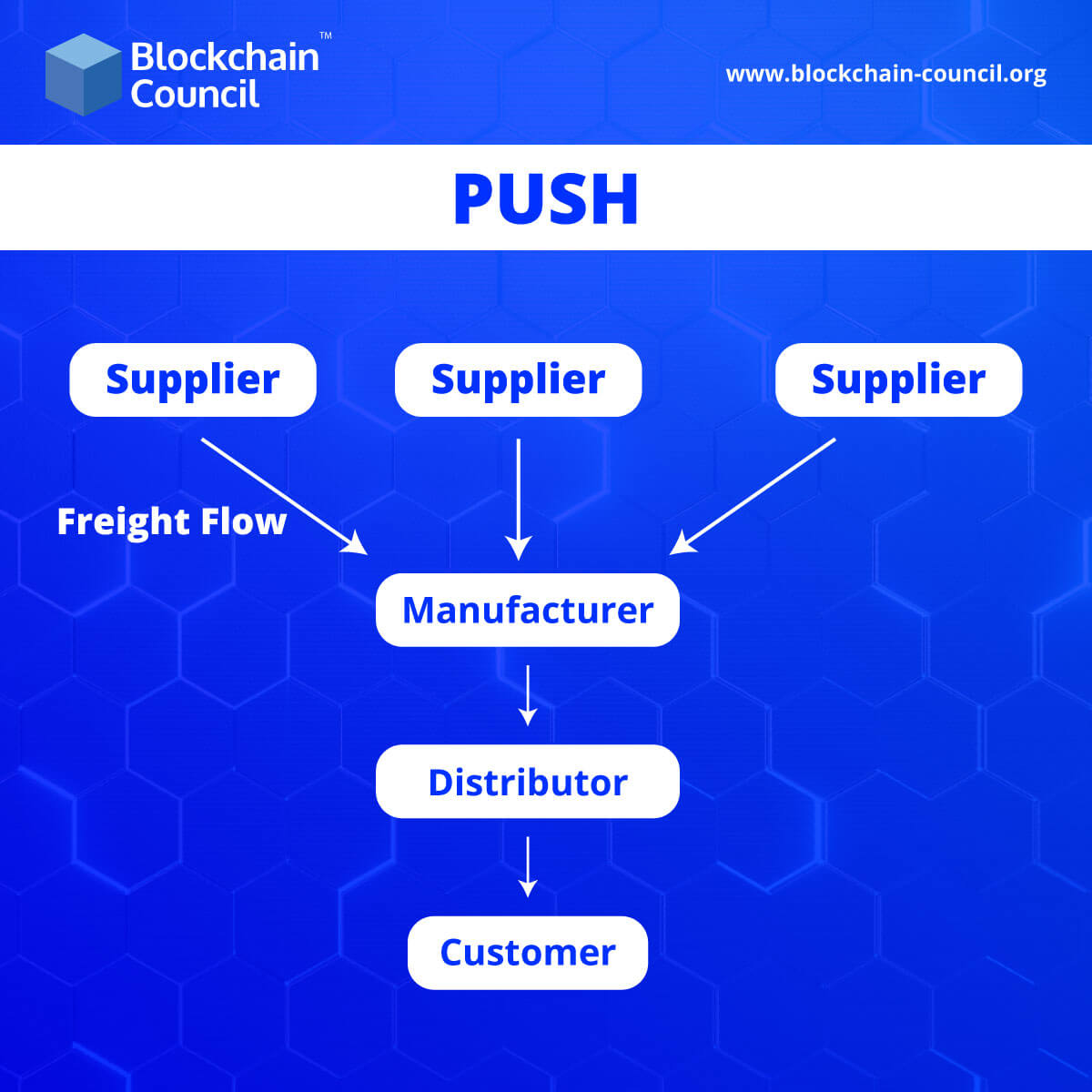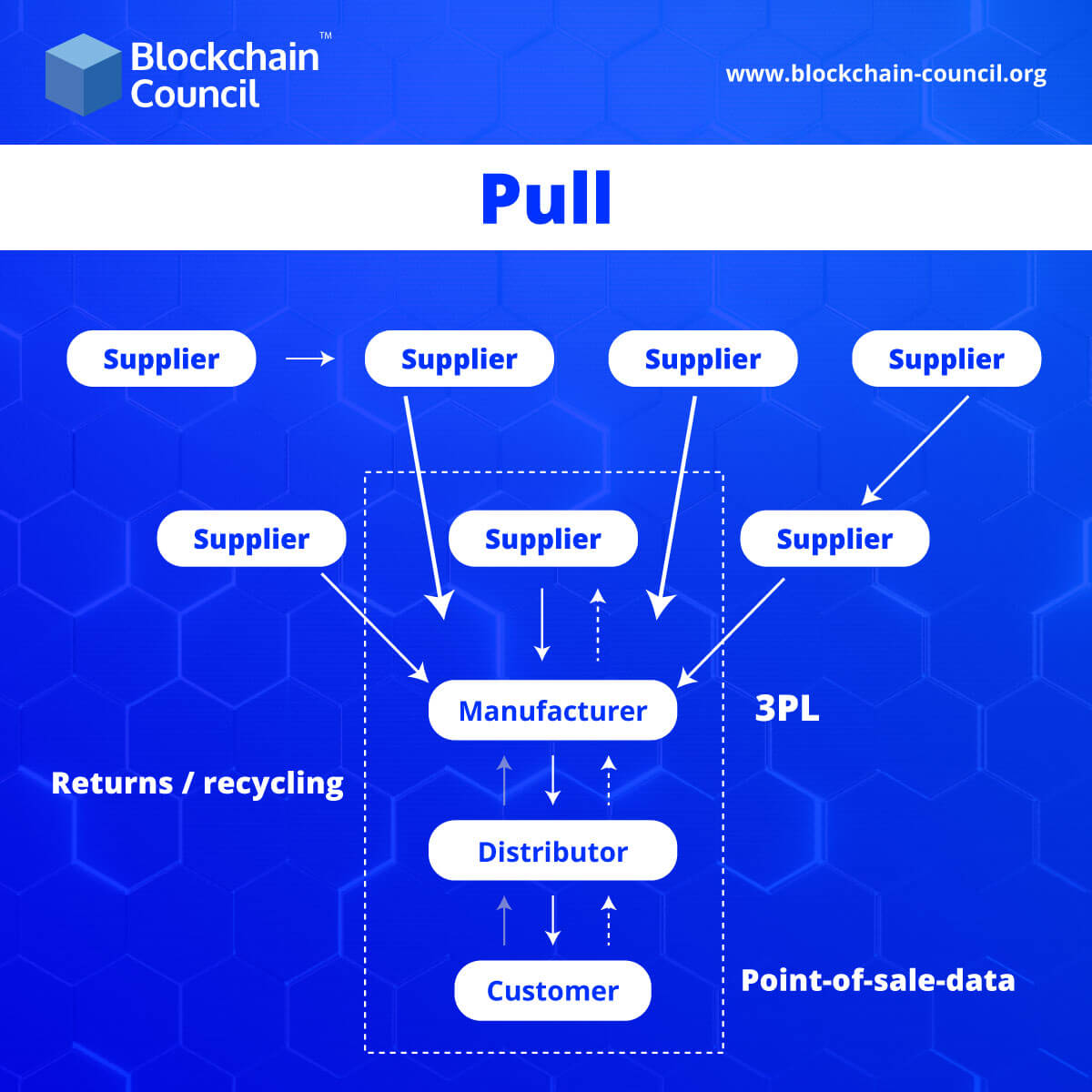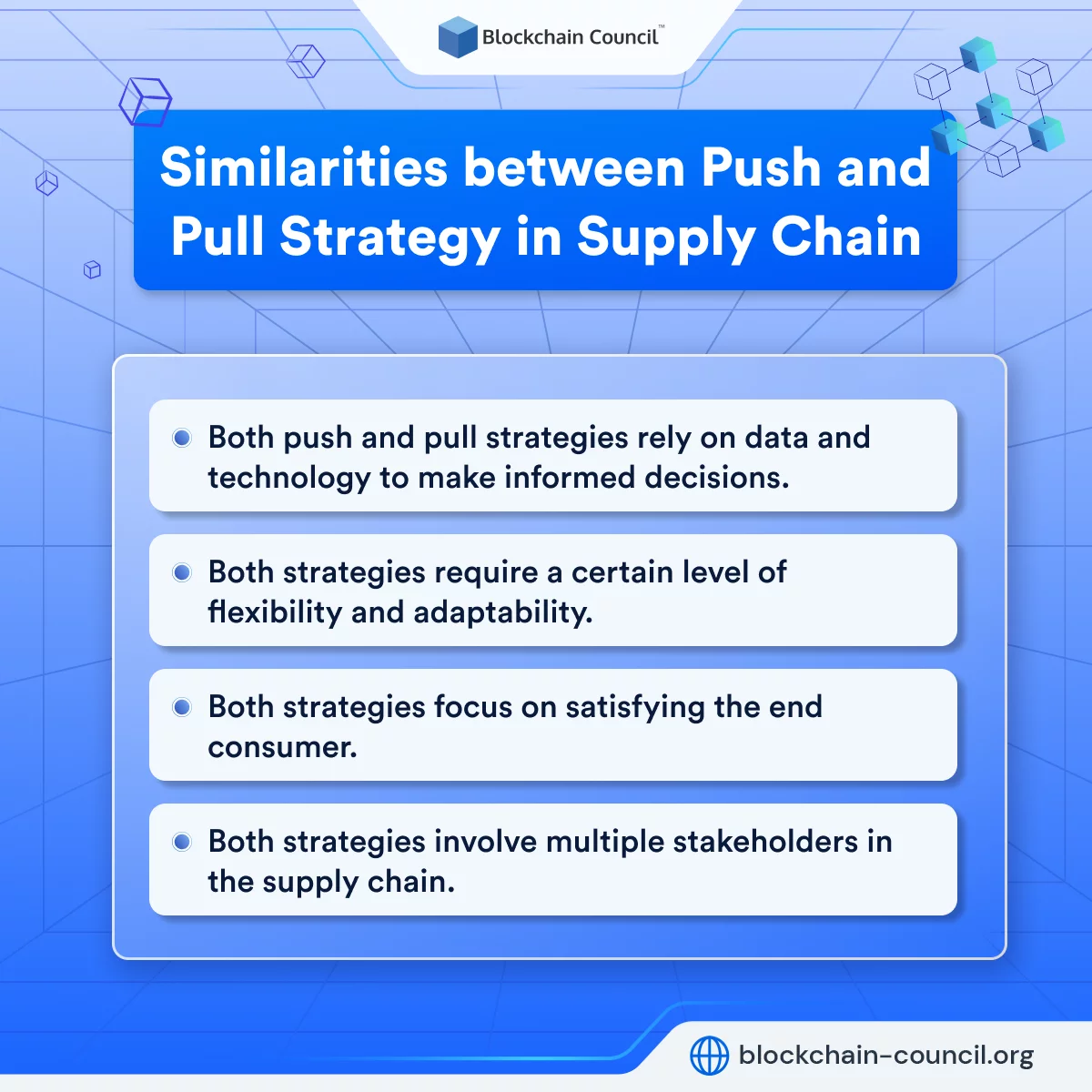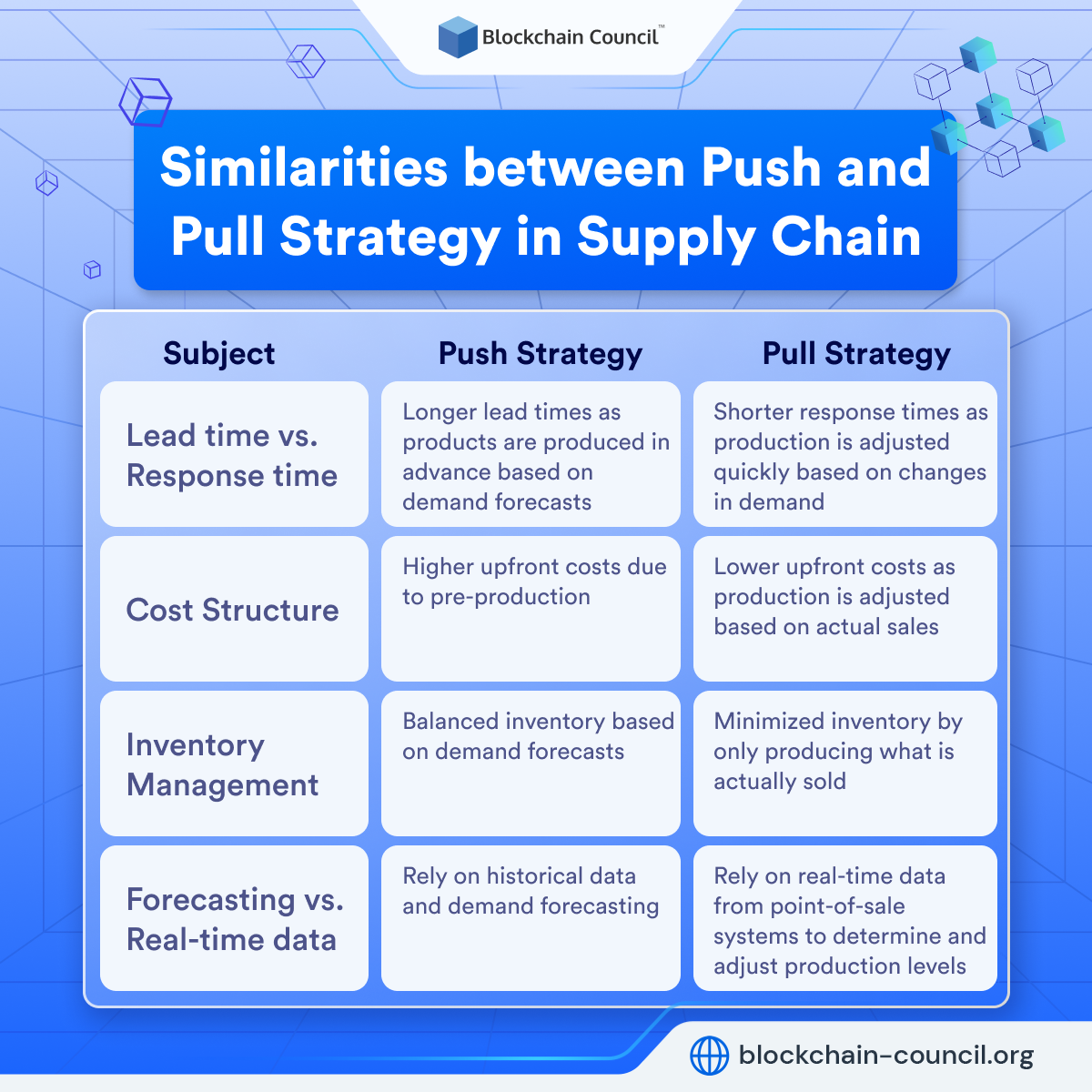
- Toshendra Kumar Sharma
- December 10, 2024
What is Push and Pull Strategy?
Push and Pull strategies are two fundamental approaches to managing the flow of goods and services from production to the end customer. Each strategy has its own advantages, challenges, and suitable applications depending on the type of products, market demand, and business objectives. Let’s explore it in detail.
Push Strategy in Supply Chain Management

Under the push supply chain, the logistics are driven by long-term projections of customer demand. For example, at the end of the summer season, clothing brands start to manufacture more warm clothes. This type of planning becomes valuable to companies as it helps them plan for events in the future and be prepared when winter comes. This gives the companies time to meet their needs and time to figure out other logistics like where to store the inventory.
But instead of responding to actual demand, a push strategy relies on often wrong predictions. Improved forecasting accuracy could help mitigate some challenges, but high variable expenses, divestments, discounting, missed sales, stock shortages, high levels of debt, and rescheduled production cycles remain significant drawbacks of this approach.
Aspiring to Become a Certified Blockchain Developer? Enroll in Blockchain Developer Certification Now!
Advantages of Push Strategy
Better Inventory Control: A key advantage of a push strategy in a supply chain is better inventory control. Using the push strategy, manufacturers can produce products in advance, stock them, and then sell them with rising demand. This reduces the risk of stock-outs. Notably, stock-outs can lead to lost sales and customer frustration. Further, manufacturers can also reduce the risk of overstocking and related costs by using a push strategy.
Forecasting Accuracy: A push strategy in the supply chain helps manufacturers have a better understanding of demand patterns. Using the push strategy, manufacturers can have a more accurate view of the market. This leads to improved forecasting accuracy. Improved forecasting accuracy is crucial for effective planning and decision-making.
Reduced Lead Time: Another advantage of a push strategy in the supply chain is that it can reduce lead times. In this strategy, customers receive the products faster as products are produced and stocked even before the customer places an order. This can be particularly beneficial in today’s fast-moving markets where customers are looking for quick and reliable delivery.
Alignment of Supply and Demand: A push strategy can help align supply and demand in a better way. This reduces the risk of obsolescence. Using a push strategy in the supply chain, manufacturers can respond quickly to changes in demand and make necessary adjustments to production and inventory levels.
Focus on Standard Products: A push strategy in the supply chain can allow manufacturers to focus on producing standard products in high volume. This will help in reducing costs and improve efficiency. As production processes can be streamlined using a push strategy, the production of standard products will increase.
Limitations of Push Strategy
Customer Demand Variability: In a push strategy, products are manufactured based on forecasts and pushed into the market. However, unpredictable changes in customer demand can lead to inventory imbalances and excess stock. This challenge highlights the importance of accurate demand forecasting and the need to adapt quickly to dynamic market conditions.
Inventory Management: Push strategy relies on maintaining high inventory levels to meet anticipated demand. However, this approach can result in carrying costs, product obsolescence, and the risk of stockouts. Effective inventory management techniques, such as just-in-time (JIT) inventory, can help address these challenges by minimizing holding costs and optimizing stock levels.
Production Planning: Aligning production capacity with anticipated demand is a crucial aspect of push strategy. Insufficient production capacity can lead to delays and missed delivery deadlines. Implementing efficient production planning processes, such as capacity analysis and resource optimization, can enhance production capabilities and minimize bottlenecks.
Information Sharing in the Supply Chain: In a push strategy, effective communication and information sharing among supply chain partners become critical. Lack of real-time data exchange and collaboration can lead to inaccurate forecasts, delayed responses, and inefficient operations. Embracing technology-driven solutions like integrated information systems and collaborative platforms can foster seamless communication and enhance overall supply chain performance.
Real-world examples of Push Strategy
- FMCG (Fast Moving Consumer Goods) companies such as Unilever and Coca-Cola use a push strategy in their supply chain management. They predict consumer demand for their products and then push their inventory to retail stores and meet the increasing demand.
- Toy manufacturing company Lego uses a push strategy very effectively. They anticipate consumer demand for certain toys during holidays and peak periods and use a push strategy in their supply chain management to produce in-demand products in high volume.
- Book publishers such as Penguin Random House, HarperCollins, and Simon & Schuster use a push strategy in their supply chain management. These publishers forecast the demand for new releases and stock their inventory in bookstores and online retailers even before the releases are available for readers to buy.
Pull Strategy in Supply Chain Management
Under the pull supply chain, the manufacturing and supply process is driven by actual customer demand. In this type of supply chain logistics, inventory is acquired on a need basis. This type of planning benefits includes less wastage in the case of lower demand. The problem, however, is that the company might not have enough inventory to meet rising demands due to unforeseen factors. For example, an auto repair shop only orders the parts it needs. In this case, the business waits until it gets an order to procure the parts required for the repair.
Advantages of Pull Strategy
Enhanced Customer Relationships: Satisfied customers are the lifeline of any business. A pull strategy in supply chain management can help businesses build strong, long-lasting relationships with their customers. Businesses can use a pull strategy to demonstrate a commitment to customer satisfaction by quickly and accurately fulfilling customer demand. This can lead to increased customer loyalty and customer requisition rate.
Dynamic Response to Customer Demand: One of the key benefits of a pull strategy is that it allows businesses to respond dynamically to changing customer demand. This strategy helps manufacturers closely monitor customer behavior. It helps them to adjust production and delivery. Pull strategy helps businesses to survive even in a highly competitive market.
Better Quality Control: With a pull strategy in the supply chain, businesses can take a more hands-on approach to quality control. In a pull strategy, businesses only produce products when they are needed. This allows businesses to produce only high-quality products.
Sustainable Supply Chain: A pull strategy in supply chain management can help businesses reduce waste, minimize surplus inventory, and improve overall sustainability. Businesses produce products as they are needed using a pull strategy. Further, using this strategy, manufacturers can closely monitor demand and reduce their environmental impact.
Better Resource Allocation: A pull strategy in supply chain management can help businesses allocate their resources more effectively. Businesses using this strategy are not tied up in surplus inventory or overproduction. They can also avoid the need for large amounts of working capital to support surplus inventory. This can result in improved cash flow and resource utilization and save costs.
A successful supply chain strategy relies not just on its logistics but also on the efficacy of leadership within manufacturing units. This is where focused development programs such as Leadership training for manufacturing supervisors come into play. By equipping supervisors with strong communication skills, process optimization knowledge, and conflict management tactics, manufacturers can ensure smoother operations and more agile responses to demand fluctuations.
Limitations of Pull Strategy
Order Fulfillment: In pull strategy, products are manufactured based on actual customer demand. However, managing order fulfillment efficiently poses challenges such as lead time reduction, ensuring product availability, and minimizing stockouts. Streamlining order processing, optimizing logistics networks, and implementing robust demand-driven replenishment systems can alleviate these challenges.
Bullwhip Effect: The bullwhip effect refers to the amplification of demand fluctuations as they propagate upstream in the supply chain. This phenomenon can result in excessive inventory, inefficient resource allocation, and increased costs. Employing collaborative forecasting techniques, sharing real-time sales data, and fostering strong relationships with suppliers can mitigate the bullwhip effect and improve supply chain coordination.
Technology and Automation: Leveraging technology in a pull strategy can enhance visibility, enable accurate demand sensing, and automate various supply chain processes. Integration of advanced technologies like Artificial Intelligence (AI), Internet of Things (IoT), and predictive analytics can enable real-time demand monitoring, efficient order processing, and proactive inventory management.
Real-world examples of Pull Strategy
- Toyota is a well-known example of a company that uses a pull strategy in its supply chain management through Just-in-Time (JIT) manufacturing. Instead of producing large quantities of a product ahead of time and storing it in a warehouse, JIT manufacturing produces products only when there is an actual demand for them. This approach helps reduce inventory costs and waste. This pull strategy also helps in increasing efficiency by only producing what is needed.
- Many companies, such as UPS and FedEx, use a pull strategy in their reverse logistics operations. These companies pick up returned products from customers only after they have placed a return request. This helps to reduce the amount of unnecessary transportation and handling of returned products. Using a pull strategy here also helps in minimizing the amount of inventory that needs to be stored in a warehouse.
- Companies like Vistaprint use a pull strategy. They produce printed products, such as t-shirts and business cards, only after a customer places an order. This helps to reduce waste and the cost of maintaining a large inventory.
Solution to address the challenges in push and pull strategy
Supply Chain Optimization
Regardless of the strategy employed, supply chain optimization is key to overcoming challenges. This involves aligning supply and demand, optimizing inventory levels, improving production efficiency, and enhancing logistics and distribution networks. Implementing robust supply chain management practices and employing data-driven decision-making can drive significant improvements.
Performance Metrics
Establishing performance metrics allows organizations to track and evaluate their supply chain effectiveness. Key performance indicators (KPIs) such as on-time delivery, fill rate, inventory turnover, and customer satisfaction provide valuable insights into the efficiency and effectiveness of push and pull strategies. Monitoring and continuously improving these metrics enable organizations to adapt and optimize their operations.
Collaboration in Supply Chain
Collaboration among supply chain partners is crucial in both push and pull strategies. By fostering strong relationships with suppliers, manufacturers, distributors, and retailers, organizations can enhance coordination, improve information sharing, and reduce lead times. By prioritizing collaboration across the supply chain, organizations can address challenges related to information sharing, lead time reduction, and overall supply chain responsiveness. This collaborative approach creates a mutually beneficial environment where all partners work together to optimize operations, reduce costs, and deliver superior customer value.
Push vs Pull Strategy
Similarities
Despite their differences, there are some similarities between push and pull strategies in supply chain management:
- Both push and pull strategies in supply chain management rely on data and technology to make informed decisions. For example, push strategies use data such as sales history and market trends to make forecasts. Meanwhile, pull strategies use real-time data from point-of-sale systems to respond to changes in demand.
- Both strategies require a certain level of flexibility and adaptability. In a push strategy, the supply chain must be able to quickly finish production to meet an increase in demand. On the other hand, in a pull strategy, the supply chain must be able to respond quickly to changes in demand by adjusting production accordingly.
- Both strategies focus on satisfying the end consumer. No matter if it is a push strategy or a pull strategy, the supply chain must deliver the right product to the right customer at the right time.
- Both strategies involve multiple stakeholders in the supply chain. These include suppliers, manufacturers, distributors, and retailers. Each stakeholder plays a critical role in ensuring that the products reach the customers properly.
Similarities
Differences
While there are many similarities between the push and pull strategies in a supply chain, there are also several key differences between the two:
Lead time vs. Response time: Push strategies to have longer lead times. This is because, in this strategy, products are produced in advance based on demand forecasts. Meanwhile, pull strategies have shorter response times. In this strategy, production is adjusted quickly according to the changes in demand.
Cost Structure: Push strategies typically have higher upfront costs. Businesses using this strategy produce products in advance. However, businesses using the pull strategy have lower upfront costs. They adjust their production based on actual sales.
Inventory Management: Businesses using push strategies balance inventory levels based on demand forecasts. Meanwhile, pull strategies minimize inventory levels by only producing what is actually sold. This difference in inventory management can impact both the cost structure and the flexibility of the supply chain.
Forecasting vs. Real-time data: Push strategies often rely on historical data and demand forecasting to determine production levels. Meanwhile, pull strategies rely on real-time data from point-of-sale systems to determine and adjust production levels.
| Differences between Push and Pull Strategy in Supply Chain Management | ||
| Subject | Push Strategy | Pull Strategy |
| Lead time vs. Response time | Longer lead times as products are produced in advance based on demand forecasts | Shorter response times as production is adjusted quickly based on changes in demand |
| Cost Structure | Higher upfront costs due to pre-production | Lower upfront costs as production is adjusted based on actual sales |
| Inventory Management | Balanced inventory based on demand forecasts | Minimized inventory by only producing what is actually sold |
| Forecasting vs. Real-time data | Rely on historical data and demand forecasting | Rely on real-time data from point-of-sale systems to determine and adjust production levels |
Real Life Scenario
In supply chain management, understanding the differences between push and pull strategies is crucial for optimizing operations and customer satisfaction. These strategies are not mutually exclusive; many businesses employ a blend of both, depending on their specific needs and market dynamics.
Push Strategy
This approach is proactive, where production and distribution decisions are based on long-term forecasts of customer demand. It’s often applied where demand uncertainty is relatively low. In a push strategy, companies produce goods in anticipation of future demand. This is common for items with predictable demand patterns, like seasonal products. For example, a factory might produce Christmas ornaments well in advance based on expected consumer interest. The key advantage of this approach is that it allows ample time for planning raw material needs, manufacturing schedules, and logistics. However, the risks include overproduction if demand is overestimated, leading to excess inventory and potentially higher storage costs.
Pull Strategy
Contrasting with the push strategy, the pull approach is reactive, where production is driven by actual consumer demand. It is more suited to situations where demand uncertainty is high. A classic example of a pull-based supply chain is custom, made-to-order items. For instance, a high-end jeweler might only create a piece of jewelry after consulting with a customer and understanding their specific requirements. This strategy minimizes inventory costs and can allow for charging a premium for custom goods. The pull strategy’s responsiveness to customer demand can lead to higher customer satisfaction but may struggle with sudden surges in demand or supply chain disruptions.
Hybrid Strategy
Many businesses, like Walmart, use a combination of both strategies, often referred to as a hybrid push-pull system. This approach allows them to leverage the strengths of both strategies while mitigating their weaknesses. For example, Walmart uses data insights for inventory management, balancing the need to anticipate customer demand (push) with the need to respond quickly to real-time sales data (pull). This helps them enhance customer satisfaction, reduce waste, and increase revenue.
Impact of Technology
The role of technology in these strategies is significant. In push strategies, AI and machine learning can enhance forecast accuracy. In contrast, technologies like IoT and blockchain in pull strategies offer real-time visibility and secure tracking of goods, enabling quicker responses to demand changes.
Choosing the Right Strategy
The choice between push and pull strategies depends on several factors, including the nature of your products, demand predictability, market volatility, and your capability to manage real-time data. For products with predictable demand and high economies of scale, a push strategy might be more efficient. Conversely, for products with high demand uncertainty and lower economies of scale, a pull strategy could be more effective.
Implementing Push and Pull Strategy in Supply Chain Management
Steps to Implement Push Strategy
1. Demand Forecasting and Production Planning
To implement a successful push strategy, businesses must accurately forecast customer demand and plan their production accordingly. By utilizing historical data, market trends, and predictive analytics, organizations can estimate future demand, allowing them to optimize production schedules and minimize stockouts.
2. Inventory Management
Efficient inventory management is crucial in a push strategy. Organizations need to strike a balance between maintaining sufficient stock levels to meet anticipated demand and avoiding excessive inventory. Implementing technologies like RFID tagging, barcode scanning, and automated tracking systems can enhance visibility and streamline inventory management processes.
3. Distribution and Logistics
In a push strategy, distribution and logistics play a vital role in ensuring timely delivery of products to customers. Establishing strong partnerships with reliable logistics providers, optimizing transportation routes, and leveraging advanced tracking systems are essential steps to minimize lead times and enhance overall supply chain efficiency.
4. Performance Monitoring and Continuous Improvement
To sustain and improve the push strategy, organizations must monitor key performance indicators (KPIs) and implement a culture of continuous improvement. Regularly analyzing metrics such as order fulfillment time, production efficiency, and customer satisfaction enables businesses to identify areas for enhancement and drive operational excellence.
Steps to Implement Pull Strategy
1. Establishing Customer Demand Signals
Unlike the proactive nature of the push strategy, the pull strategy focuses on responding to customer demand signals. Implementing robust communication channels and feedback mechanisms enables organizations to capture accurate customer demand data. These signals can include purchase orders, sales data, customer surveys, or even social media interactions.
2. Lean Manufacturing and Just-in-Time (JIT) Principles
To implement a pull strategy effectively, organizations should adopt lean manufacturing principles and just-in-time (JIT) practices. By minimizing waste, reducing lead times, and synchronizing production with actual demand, businesses can achieve greater efficiency, cost savings, and improved customer responsiveness.
3. Collaborative Planning, Forecasting, and Replenishment (CPFR)
Collaboration is key in a pull strategy. Establishing strong partnerships with suppliers, distributors, and retailers facilitates collaborative planning, forecasting, and replenishment (CPFR). Sharing demand data, conducting joint forecasting, and coordinating replenishment activities can streamline the entire supply chain, reducing inventory holding costs and enhancing overall responsiveness.
4. Evaluating and Adjusting the Pull Strategy
Continuous evaluation is crucial in a pull strategy to ensure its effectiveness. By monitoring customer demand patterns, analyzing order fulfillment cycles, and conducting regular reviews, organizations can identify potential bottlenecks or areas for improvement. Adjustments can be made to the supply chain configuration, inventory levels, or partnership agreements to enhance the pull strategy’s performance.
Factors to consider when choosing between strategies
Push and pull strategies in supply chain management are two distinct approaches to managing the flow of products from manufacturers to consumers. Both pull and push strategies have their own advantages and disadvantages. You should consider several key factors to ensure that you choose the right strategy that matches your business needs:
Product characteristics: You should choose between a push or pull strategy considering the nature of the product that you are selling. You should keep the product characteristics in mind, like its shelf life, demand predictability, and variability.
Cost structure: You must determine the cost structure of your business before choosing between a push or pull strategy. Do you want to minimize upfront costs? Can you risk the cost of overproduction? Push strategies have higher upfront costs. Meanwhile, pull strategies have lower upfront costs.
Market Conditions: Before choosing between a push or pull strategy, it is important to understand the target market condition and customer preferences. You must monitor customers’ purchasing behavior and demand patterns.
Push and Pull Strategies in Practise
Push and pull strategies are usually combined in practice to meet the needs of the end consumer. The process roughly consists of the following steps:
- Determining the availability of raw materials. Even before the product can begin to be made, it is important to plan where and how the raw materials can be acquired cheaply.
- Processing the raw materials in a factory to yield the final products. This step varies from company to company, like food-based products, cloth-based products, etc.
- Then the finished product is taken to a storage facility or a distribution facility.
- The packaged product is taken to a retail store or shipped directly to the customer as needed.
- Most supply chains in the world resemble this basic outline. Now, push and pull strategies can be employed by planners by taking into account the expected demand and other factors.
- The most successful shipping companies, like Walmart and Amazon, research the various factors that determine demand and incorporate that knowledge into their supply chain.
Amazon is one of the world’s biggest online retailers, managing billions of dollars worth of inventory each year. Push and Pull logistics are a big part of their inventory management. Amazon’s warehouses are strategically placed, moving closer and closer to main metropolitan areas and city centers. As a result, it uses a pure push strategy for the products it stores in its warehouses based on the downstream demand forecast. On the other hand, it uses a pure pull strategy when it sells products from third-party sellers to minimize its own risk for unsold inventory.
Trends and Innovations in Push and Pull Strategy
Industry 4.0 and Digital Transformation
Industry 4.0 is the fourth industrial revolution, which is characterized by the use of cyber-physical systems, the internet of things, and big data analytics. These technologies are transforming supply chain management (SCM) by enabling companies to better track and manage inventory, optimize transportation and logistics, and improve customer service.
One of the key ways that Industry 4.0 is transforming SCM is by enabling companies to move away from a traditional push strategy to a pull strategy. In a push strategy, companies produce goods based on forecasts of future demand. This can lead to overproduction and inventory piling up, which can be costly and inefficient. In a pull strategy, companies produce goods only when they receive orders from customers. This can help to reduce inventory costs and improve customer satisfaction.
Digital technologies are making it possible for companies to implement pull strategies more effectively. For example, companies can use sensors to track the movement of goods throughout the supply chain. This data can be used to forecast demand more accurately and to adjust production levels accordingly. Additionally, companies can use big data analytics to identify trends in customer behavior. This information can be used to predict future demand and to ensure that the right products are available in the right quantities at the right time.
The move to a pull strategy is just one example of how Industry 4.0 is transforming SCM. Other areas of transformation include:
- Real-time visibility: Companies can use sensors and other technologies to track the movement of goods in real time. This information can be used to improve decision-making and to identify and respond to problems quickly.
- Collaboration: Companies can use digital technologies to collaborate with suppliers, customers, and other partners in the supply chain. This collaboration can help to improve efficiency, reduce costs, and improve customer satisfaction.
- Automation: Companies can use robots and other automation technologies to perform tasks that were previously done by humans. This can help to improve efficiency, reduce costs, and improve safety.
Industry 4.0 is still in its early stages, but it has the potential to transform SCM in a fundamental way. By embracing digital technologies, companies can improve efficiency, reduce costs, and improve customer satisfaction.
Artificial Intelligence and Machine Learning Applications
Push strategy
A push strategy is a supply chain strategy where goods are produced and distributed in anticipation of demand. This can be a good strategy for products with relatively stable demand, as it can help to reduce costs by minimizing inventory. However, it can also lead to overstocking and waste if demand is not as expected.
AI and ML can be used to improve push strategies by:
- Predicting demand more accurately: AI and ML can be used to analyze historical data and trends to predict future demand. This can help businesses to produce and distribute the right amount of goods, avoiding overstocking and waste.
- Optimizing production and distribution: AI and ML can be used to optimize production and distribution schedules. This can help to reduce costs and improve efficiency.
- Reducing risk: AI and ML can be used to identify and mitigate risks in the supply chain. This can help to prevent disruptions and ensure that goods are delivered on time.
Pull strategy
A pull strategy is a supply chain strategy where goods are produced and distributed only in response to customer demand. This can be a good strategy for products with volatile demand, as it can help to avoid overstocking and waste. However, it can also lead to stockouts and lost sales if demand is greater than expected.
AI and ML can be used to improve pull strategies by:
- Real-time demand forecasting: AI and ML can be used to forecast demand in real time. This can help businesses to quickly adjust production and distribution schedules to meet changing demand.
- Optimizing inventory levels: AI and ML can be used to optimize inventory levels. This can help to reduce costs and improve customer service.
- Managing supply chain disruptions: AI and ML can be used to identify and mitigate supply chain disruptions. This can help to prevent disruptions and ensure that goods are delivered on time.
By using AI and ML, businesses can improve their push and pull strategies and achieve greater efficiency, profitability, and customer satisfaction.
Here are some specific examples of how AI and ML are being used in supply chain management:
- Amazon is using AI to predict demand for products. This helps them to ensure that they have the right amount of inventory on hand to meet customer demand.
- Walmart is using AI to optimize its distribution network. This helps them to reduce costs and improve delivery times.
- UPS is using AI to track its shipments. This helps them to keep customers informed of the status of their orders and to identify potential problems early on.
Sustainability and Green Supply Chains
Sustainability is a growing concern for businesses and consumers. In response, businesses are increasingly adopting sustainable practices, such as using renewable energy, reducing waste, and improving energy efficiency.
Green supply chains are one way for businesses to reduce their environmental impact. A green supply chain is a network of organizations that work together to reduce the environmental impact of the products and services they produce.
There are many benefits to using green supply chains. These benefits include:
- Reduced environmental impact: Green supply chains can help businesses reduce their environmental impact by reducing waste, improving energy efficiency, and using renewable energy.
- Increased customer satisfaction: Consumers are increasingly demanding sustainable products and services. By using green supply chains, businesses can meet this demand and increase customer satisfaction.
- Reduced costs: Green supply chains can help businesses reduce costs by reducing waste, improving energy efficiency, and using renewable energy.
Overall, green supply chains are a win-win for businesses and the environment. Businesses that adopt green supply chains can reduce their environmental impact, increase customer satisfaction, and reduce costs.
Upcoming Trends in Supply Chain Management
- Predictive Analytics and Automation: The future of supply chain management lies in predictive analytics and automation. AI-driven systems will not only forecast demand but also automate many of the decision-making processes in the supply chain, from ordering raw materials to scheduling production and distribution.
- Blockchain for Transparency and Efficiency: Blockchain technology is expected to become a staple in supply chain management. It will provide unparalleled transparency and security in transactions, tracing products from origin to consumer. This will be crucial for verifying product authenticity, ensuring ethical practices, and reducing fraud.
- Sustainable and Ethical Supply Chains: As consumers become more environmentally conscious, technology will play a key role in developing sustainable supply chains. This involves tracking the carbon footprint of products, ensuring ethical sourcing of materials, and minimizing waste through efficient logistics.
Future Implications for Businesses and Supply Chains
The continued evolution of technology in supply chains will bring several implications:
- Improved Efficiency and Cost Savings: The use of AI and IoT will streamline operations, reducing lead times and operational costs. This will be critical in maintaining competitive pricing and high customer satisfaction.
- Greater Flexibility and Resilience: Technology will enable supply chains to become more flexible and resilient, especially in adapting to unexpected disruptions. This will be crucial in a world where market conditions and consumer preferences are rapidly evolving.
- Enhanced Customer Experience: With real-time tracking and responsive supply chains, businesses can offer a more personalized and efficient customer experience. This includes faster delivery times, higher product availability, and improved after-sales service.
Conclusion
In real life, no businesses rely entirely on either push or pull logistics but instead employ a mixture of the two to make the best use of them. Modern-day supply chain operations are very complex and consist of steps from getting the raw materials to delivering the final product to the end consumer.
But here, it is crucial to note that, to build the optimal push versus pull combination, there is no one-size-fits-all approach to develop the ideal push vs. pull mix. When designing their specific combination of Push and Pull strategies, brands must understand their campaign objectives, target audience, and budget constraints.
You can respond effectively to evolving consumer demands by combining both pull and push approaches while maintaining economies of scale within your current operations.
To get instant updates about Blockchain Technology and to learn more about online Blockchain certification, check out Blockchain Council.
If you want to keep up with the trends of the Blockchain industry, join our communities on Discord, Reddit, and Telegram.
FAQ
What is the push and pull strategy in supply chain management?
- The push and pull strategy in supply chain management refers to two different approaches to managing the flow of goods and materials within a supply chain.
- The “push” strategy focuses on predicting demand and producing products in advance to meet that demand, while the “pull” strategy focuses on responding to actual customer demand by producing goods only when they are ordered.
What are the benefits of using a pull strategy in supply chain management?
- The main benefits of using a pull strategy in supply chain management are improved responsiveness to customer demand, reduced inventory costs, and greater flexibility in production.
- With a pull strategy, companies can respond more quickly to changes in customer demand, reduce the amount of inventory they need to hold, and adjust production more easily to meet changing demand pattern.
What are the challenges of using a push strategy in supply chain management?
- The main challenges of using a push strategy in supply chain management include the difficulty of accurately predicting demand, the risk of excess inventory and obsolescence, and the higher costs associated with producing goods in advance of demand.
- Additionally, a push strategy may lead to longer lead times and reduced flexibility in production.
When is it appropriate to use a push strategy in supply chain management?
- A push strategy may be appropriate in supply chain management when demand for a product is relatively predictable and stable, or when the cost of carrying inventory is relatively low.
- Additionally, a push strategy may be a good fit for products with long lead times or those that are expensive to produce.
How can a company balance its use of push and pull strategies in supply chain management?
- A company can balance its use of push and pull strategies in supply chain management by using a combination of both strategies, depending on the product and the market conditions.
- For example, a company may use a push strategy for products with predictable demand and a pull strategy for products with more volatile demand.
- Additionally, a company may use a push strategy for products with long lead times and a pull strategy for products with shorter lead times.
- By using a balanced approach, companies can take advantage of the benefits of both strategies while minimizing the risks and costs associated with each approach.








































































 Guides
Guides News
News Blockchain
Blockchain Cryptocurrency
& Digital Assets
Cryptocurrency
& Digital Assets Web3
Web3 Metaverse & NFTs
Metaverse & NFTs
